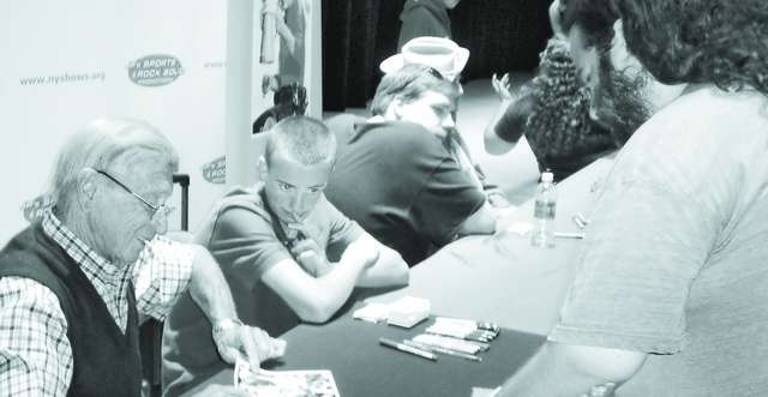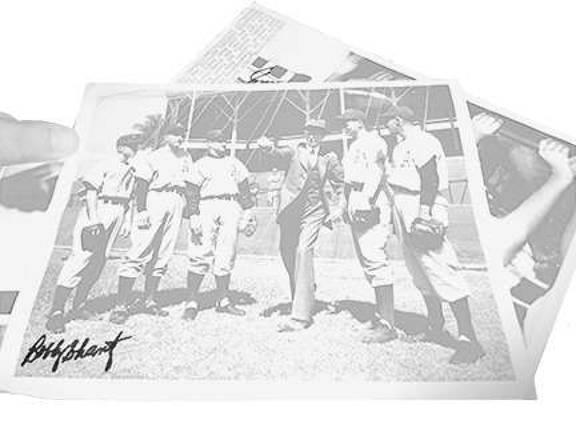Bobby Shantz, 1952 MVP and member of 58' Yankees WS team, greets fans



BY NATHAN MAYBERG
For Yankees fans of a certain time, Bobby Shantz is remembered for his 1957 season when he led the American League with the lowest Earned Run Average and helped guide the Bronx Bombers to the World Series which they lost to the Milwaukee Braves.
He is also one of the few pitchers to have been named MVP of the league, which he was awarded in 1952 after leading the American League with a 24-7 record and the fewest walks and hits allowed per inning. His 2.38 E.R.A. was third best.
Last month, the 88-year-old lefty was signing autographs for free at the Westchester County Center in White Plains during a baseball card show before a long line of young and old.
He is one of the last links alive to the great 1950s teams of Mickey Mantle, Yogi Berra and Whitey Ford.
Philadelphia A's
Shantz is also one of the very last to have played under Connie Mack, the Hall of Fame manager and owner of the Philadelphia Athletics who holds the record for most wins and stopped coaching in 1950 at the age of 88.
Shantz’s first two years in the big leagues were under Mack, whom he and everyone on th eteam called “Mr. Mack.”
The Pennsylvania native entered the big leagues at the age of 24 but only spent one year in the minors.
He had been discovered in rural Pennsylvania, by an A’s scout in 1948, while playing for a semi-pro team.
“I guess he thought I had a pretty good curveball,” Shantz said of the scout. “I never had a really good fastball but it moved pretty good.”
He was working in a sand mill at the time. “I didn’t want to quit my job but my dad told me to go,” Shantz said.
His late younger brother, Billy, would follow him to the A’s a few years later and also played on the Yankees.
Shantz said Mr. Mack, known for wearing a suit during games, building and managing two of the great baseball dynasties (1910-14 A’s and 1929-31 A’s), wasn’t that involved with the day to day coaching by the time he played for him.
“He never had too many meetings or anything. He didn’t actually have too much to do with the club. He just sat there with his hat on. His son Earl did most of the coaching,” Shantz said. “He was a nice man,” Shantz said about the elder Mack. “Very quiet. Never said too much,” Shantz said.
Mickey Cochrane, arguably the best all around catcher to play the game, and who won two world championships for Mack while catching Lefty Grove –one of the finest hurlers the game has seen, was Shantz’s first pitching coach. “He was mean. He expected a lot. He was kind of a tough guy. Very stern,” Shantz said.
Another coach on the team, Bing Miller, had also been on those two championship teams playing in the shadows of Hall of Famers like Cochrane, Grove and Al Simmons.
A .311 career hitter as a player and borderline Hall of Famer himself, Miller was just the opposite of Cochrane. He was jovial and outgoing, Shantz said.
Chief Bender, another Hall of Famer who played under Mack, took over as pitching coach from Cochrane. Bender won three World Series rings in five tries for the A’s between 1910 and 1913, three of which he was completely dominant in. Shantz said he wasn’t aware of Bender’s resume at the time. “I never really followed baseball. He was quiet. He didn’t say too much. The chief didn’t say too much.”
Shantz credited his catcher Joe Astroth with helping him the most, by telling him to change speeds with his fastball. “After that I won a lot of ballgames. If it wasn’t for him telling me, I probably wouldn’t have lasted 16 years.”
Unlike today’s pitchers who all seem to be able to blow out above 90 miles per hour, Shantz doesn’t think he hit near 90. “I’m just guessing but I would say around 85 miles per hour but that might have been high,” he said.
Shantz also had a knuckleball but said Mack told him not to throw it. “He thought I would hurt my arm I guess,” Shantz said.
In 1951, Jimmy Dykes, another member of the previous A’s dynasty as an infielder and then a longtime manager of the White Sox, took over coaching duties from Mack. Dykes told Shantz to throw the knuckler.
At first, “I didn’t have that good of control over it,” Shantz said. But by 1952, he had mastered the pitch.
“It turned out to be a pretty good pitch,” he said.
“I was very lucky. I couldn’t do anything wrong that year. Everything I did was right.” He had 24 wins and 27 complete games.
After dominating American League batters throughout the year with his four pitch arsenal, he went up to bat against the Washington Senators as AL pitchers did before the designated hitter. In a game during the last week of the season, Walt Masterson hurled a ball high and inside towards him.
“I probably should have let it hit me,” he said. Instead, he put his arms up, and broke two bones in his wrist.
He would never be the same again. “I didn’t have the same snap on my curveball,” he said. A shoulder injury the next year would sideline him further.
The Yankees
Shantz was converted into a reliever by the A's and in 1957, he was traded from the now Kansas City A’s to the Yankees. Whitey Ford had been injured and Shantz was called upon to start in 21 games.
He ended up leading the American League with a 2.45 E.R.A. Asked how he turned things around, Shantz replied simply “I don’t know.”
The Yankees were led by the legendary slugger Mickey Mantle. “A nice guy. Good ballplayer. I’m glad I didn’t have to pitch against him (while) on the Yankees,” Shantz said.
The team was managed by Hall of Famer Casey Stengel. “He slept most of time,” Shantz said, calling him “funny.”
Shantz threw to both Berra and Elston Howard on those teams. Howard was the better catcher, he said. “He moved that glove around to get pitches for you.”
Berra, a three-time MVP, “didn’t care about catching,” Shantz said. “He was more interested in hitting.”
Shantz pitched in the World Series that year but didn’t get a win. The Yankees were beaten by Hank Aaron, Eddie Mathews and the Milwaukee Braves. “Aaron was tough,” he said.
The Yankees won the World Series over the Braves the next year in a seven-game rematch. Shantz didn’t pitch in that one but would get his lone ring that year. He was a key part of the team as a spot starter and long reliever. While the Yankees didn’t make it to the World Series in 1959, he had a 2.38 E.R.A. that year, averaging three innings of relief a game. He helped the Yanks to a trip back to the Series in 1960 with a 2.79 E.R.A., when they lost one of the great series in history to the Pirates. He only allow four hits and a walk in six and one-third innings of relief though he was charged with three runs.
The southpaw was traded to the Pirates the next year. In 1962, he pitched for the St. Louis Cardinals and Houston Colt 45’s in relief, posting a miniscule 1.95 E.R.A., the lowest of his career.
Shantz was toughest against lefties. Roger Maris was 2 for 15 lifetime against him. Hall of Fame slugger Willie McCovey went 0 for 8 against him. Hall of Famer Billy Williams went 1 for 11. Another Hall of Fame lefty, Johnny Mize, batted .143 against Shantz in 47 at bats.